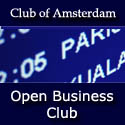|
|
|
| .A
Future Love Story |

|
|
By
Marcel van der Drift
Twenty years from
now, a cell phone gently sinks to the bottom of the river. It's one
of the latest models. The clever design, trendy colours and nifty
features make our cell phones look ancient. Everything about it is
new. Cell phone isn't even the right name for it. It's hard to describe
exactly what it is. So I won't. |
|
Anyway, this phone, for lack of a better word, belongs to Steve,
who is on the bridge, feeling generally depressed, but for the moment
happy to be rid of his phone. It was a powerful gesture.
|
|
|
Steve got wired up
only half a year ago, after everyone else had been wired up for
years.
People used to ask: "Are you wired
up?" That question was soon followed by: "Why aren't
you wired up? Are you religious? Aren't you curious?" They
looked at him suspiciously and you could hear them think: "he
must be suppressing something. Definitely some sort of denial."
Getting wired up means having all sorts
of sensors either implanted or attached to your clothes.
They're connected to your cell phone to
monitor heart rate, temperature, the sound of your voice, the
position of shoulders, hands and feet, chemicals in the blood
and what not. These sensors have been around for decades, even
small portable ones. Their first use was medical: monitoring health
and medication, correcting bad posture and compensating all sorts
of disabilities. They had also been used successfully in psychology:
monitoring body language, metabolism and chemicals in the brain.
Data was gathered from many patients over time, giving new insights
into psychological disorders. But it only took off when some clever
marketing guy, later to become yet another trillionaire, realized
their combined potential for the consumer market. When people
started using their game consoles to train their memories and
concentration, he thought: "Maybe they'd like to know about
their emotions." By then, sensors and software could read
people like a book. This marketing whiz quickly teamed up with
academic researchers and major producers of sensors. And suddenly
there was this huge company selling "insight, one-ness and
emotional connectivity." It started an industry of self-reflection,
mood blogging, mood matching, real-time automated flirt coaching
and some embarrassing employment relation strategies.
Steve, however, was reluctant. He didn't need any software to
tell him how he felt. He was depressed. Three years after losing
his job as a garbage collector to some smart-ass system, he was
definitely depressed. But he was determined to handle it on his
own, as he always had. Then Steve got even more depressed. When
he finally decided to get help, he skipped the on-line forums
and arranged a face-to-face talk with an old fashioned trained
expert: R.L. Steinberg, MD, psychiatrist. Doctor Steinbergs first
question to Steve was: "Are you wired up?"
- "No, I'm not," he sighed.
"Is there any particular reason you're not wired up?"
At this point he used to express his concern about privacy and
security, but that argument didn't seem to convince anyone anymore.
- "I don't need it. I know how I feel."
"I see. Of course self-reflection is the best tool. And I'm
sure we canunderstand your situation by discussing it here. But
some data would be very useful. You see, the way we see ourselves
is often different from the way we actually behave. When a child
is frustrated, it doesn't say 'I'm frustrated.' It just starts
kicking things over. It needs to be taught then and there, by
adults who understand this behavior, that what he is feeling is
frustration and it can be expressed in different ways. Even adults
have difficulty understanding their emotions at some point in
their lives. They mostly need feedback from others, but they also
gain insight into themselves from a higher perspective, so to
say, from objective long-term observation of their behavior. It's
no magic, but a usefultool."
-"I see."
"I suggest you get wired up without any interpretation software.
You'll just get the sensors and leave the rest to me. All that
software just oversimplifies everything anyway. We can look at
some of the data during our meetings, if need be."
So Steve got wired
up. He met doctor Steinberg every Tuesday and promised to follow
his advice on exercise, sleep, diet, etc. But he couldn't get
himself to actually do all those things. The meetings with doctor
Steinberg, who confronted him with data to prove his lack of motivation,
got more and more embarrassing. Eventually he stopped seeing him.
Instead, he downloaded the latest interpretation software.
During the installation
he opted for 'brutally honest' instead of 'constructive' or 'positive'.
Now he wasn't depressed. He was "lethargic, unconcentrated
and easily agitated." "So be it," he thought to
himself as he scrolled through the diagnosis on his cell phone.
It also said "hungry". "Am I hungry? Well, come
to think of it, I am." And he told his phone "I'd like
to order a chicken curry, anywhere." It replied "Chicken
curry has been ordered at Phonsawan, located ten minutes from
here." His left shoe started vibrating, so he turned left.
As he walked to Phonsawan restaurant for the first time in his
life, he thought: "Funny how quickly you get used to this
stuff. Three months ago, when my shoes first started vibrating,
my first impulse was to kick them off. Now I'm not even aware
of them. I just turn left or right because that's where I need
to go." He read somewhere that shopping malls are installing
vibrating floors just to lure customers into expensive stores.
He even checked to see if it was a hoax. One site strongly denied
these claims, but it seemed to be sponsored by the same shopping
mall. That didn't have to mean anything though, because those
ads are placed anywhere automatically, or so he thought. He didn't
feel like digging any deeper. True or not, he decided vibrating
floors in shopping malls were very unlikely. Right then, both
his shoes vibrated shortly, indicating he had arrived at the restaurant,
just as planned. He wasn't at some expensive store and this somehow
proved his point.
The rest of the evening
was spent eating curry, staring at the waitress, ordering beer,
staring at the waitress and ordering one or two more beers while
staring at the waitress. In the end Steve felt better than after
any meeting with doctor Steinberg. As he walked out of the restaurant
...
|
Read the full story
 click
here
click
here |
| |

|
| .Club
of Amsterdam blog |

|
 |
 Club
of Amsterdam blog
Club
of Amsterdam blog
http://clubofamsterdam.blogspot.com
September 20:  A Future Love Story
A Future Love Story
September 17:  The
Future of Business Meetings: Applications for AMI Technologies
The
Future of Business Meetings: Applications for AMI Technologies
August
16 :  Q&A
with Igor van Gemert
Q&A
with Igor van Gemert
June 19:  The
Innovation Manifesto
The
Innovation Manifesto
|

|
| .News
about Business Meetings |
| |
|
|
 |
|
 Pro-active
Meeting Assistants: Attention Please!
Pro-active
Meeting Assistants: Attention Please!
[...] There is also evidence that technology-enabled processes can
positively impact meeting performance. Studies reported by De Vreede
and Nunamaker show a significant reduction in labor cost and overall
project duration when Group Support Systems or Electronic Meeting
Systems are used. [...]
|
| |
|
|
 |
|
 Virtual
Meeting Rooms: From Observation to Simulation
Virtual
Meeting Rooms: From Observation to Simulation
Virtual meeting rooms are used for simulation
of real meeting behavior and can show how people behave, how they
gesture, move their heads, bodies, their gaze behavior during conversations.
They are used for visualising models of meeting behavior, and they
can be used for the evaluation of these models. They are also used
to show the effects of controlling certain parameters on the behavior
and in experiments to see what the effect is on communication when
various channels of information - speech, gaze, gesture, posture -
are switched off or manipulated in other ways. The paper presents
the various stages in the development of a virtual meeting room as
well and illustrates its uses by presenting some results of experiments
to see whether human judges can induce conversational roles in a virtual
meeting situation when they only see the head movements of participants
in the meeting. |

|
|
|
| .News
about the Future |
| |
|
|
 |
|
 Transatlantic21
Transatlantic21
"SUN21" is a 14-meter-long catamaran
powered exclusively by solar energy. In the fall of 2006, the ship
will undertake the first motorized crossing of the Atlantic without
using a drop of gasoline. This new world record will demonstrate the
great potential of the solar technique for ocean navigation.
|
| |
|
|
 |
|
 Energy
Research Council
Energy
Research Council
MIT has established the Energy Research
Council to spearhead efforts to address the world's mounting energy
problems.
MIT President Susan
Hockfield has announced the establishment of the MIT Energy Initiative
(MITEI), in line with the recommendations of an Institute-wide group
of faculty convened in June 2005 to help MIT understand how best
to tackle the world's energy crisis.
Hockfield thanked the
members of the Energy Research Council (ERC) for articulating recommendations
that will allow MIT, with its unique talents and capabilities, to
address what she called "one of the most urgent challenges
of our time."
|

|
|
|
| .Next
Event |

|
|
 Cross
Media CEO Breakfast
Cross
Media CEO Breakfast
September 27,
2006, 08:30 - 10:00
Location: Westergasfabriek, Oostelijke Meterhuis, Haarlemmerweg 8-10,
1014 BE Amsterdam
Entertainment,
content, advertising, video, wireless, media rights, news, movies,
TV, games, blogging, SMS ...
Meet the Experts:
Gabriele Gresta,
Deputy Chairman, Digital Magics Group (Italy)
Madanmohan Rao,
Consultant and prolific writer from Bangalore, Research Director,
Asian Media Information and Communication centre (AMIC), Singapore
Sylvia
Paull, Founder,
Berkeley Cybersalon (United States)
Mary
Hodder,
CEO, Dabble (United States)
Igor van Gemert,
Founder
& CEO, Innergy Creations BV
Jonathan Marks,
Director, Critical Distance BV
Arnold Smeulders,
Intelligent Systems Lab Amsterdam (ISLA)
Simon Jones, Director,
Human-Computer Studies Laboratory, University of Amsterdam
Moderated
by Bob Stumpel, Result
Strategy, Cellspace,
OpenBC, Ideabroker, LBI, GetMobile, TCS, Mendix, FON
For decision makers in industry,
government, science and education.
There are only a few seats left! |

|
|
|
| .”My
Genes, My Health” |
| |
|
|

|
|
Chris
De Bruijn
Chairman International Molecular Medicine Foundation,
Breda, The Netherlands
Scientific Director, Institute of Personalised Preventive Medicine,
Velen, Germany |
|
Aging and chronic dege-nerative
diseases are logic consequences of life. Our genes and our life
style determine the pace at which we age and the individual health
risks that come with aging. Modern molecular medicine offers options
to use this knowledge, especially in view of individual health risk
reduction (= pre-vention).
Evolution and
gene-compatibility
Aging is a normal biological process. It is the logic consequence
of the fact, that we can only exist and survive thanks to the
use of the oxygen that we breath and thanks to the interaction
between our genes and triggers coming from abroad (e.g. food).
During the several million years of evolution of Homo sapiens,
a delicate pattern of gene-environment interactions has developed
that made our species so succesfull.
Succesfull (healthy)
survival has a lot to do with “living up to your genes”,
which means that there must be a certain degree of compatibility
between the life-style pattern “dictated” by evolution
and an individual´s life-style. It has become clear, that
the dietary and life-style habits in the industrialised countries
are far from “gene compatible”. The majority of today´s
nutritional ingredients ingredients are “not known”
to our genes, as is the lack of adequate physical activity. As
a result, many body functions suffer from this incompatibilty,
which is always characterised by the occurrence of chronic inflammatory
processes.
Genetic individuality
Recent research from
several disciplines (molecular biology, nutritional sciences,
pharmacology) shows that the effects of identical external triggers
(food, alcohol, pharmaceutical drugs etc.) can have widely varying
effects on different individuals. It has been demonstrated that
among the human population genes are present in variant forms.
These variants have very small structural differences, for instance
just one single nucleotide out of the several hundred nucleotides
that form a gene.
Such variant forms
(single nucleotide polymorphisms; SNP’s) give rise to proteins
with a slightly different structure. A variant protein may work
satisfactorily under normal conditions, but when it gets under
pressure (for instance, in case of a chronic infection or during
the metabolism of certain food components or medicaments), it
might perform less adequately and cause an imbalance in the regulating
mechanisms of the homeostatic “maintaining system” of
the body. If not brought back ...
|
Read the full article
in the  Summit
for the Future Report 2006!
Summit
for the Future Report 2006!
You
can listen to his presentation and download it as an mp3 file
in our
 Jukebox
Jukebox
|

|
|
|
| .Recommended
Book |
| |
|
|
 |
|
 Business
Communication Design: Creativity, Strategies, and Solutions
Business
Communication Design: Creativity, Strategies, and Solutions
by Pamela Angell and Teeanna Rizkallah
Business Communication Design: Creativity, Strategies, Solutions by
Pamela Angell emphasizes the role of critical and creative thinking
in the communication process. Students learn a systematic approach
to designing messages for every business communication situation.
The authors offer a simple yet effective model for message design
that focuses on the needs of the people involved in the communication
and the circumstances of the message. Business Communication Design
addresses the variety of communication options that modern workers
face.
|

|
|
|
| .October
5: the future of
Business Meetings |
|
|
|
 the
future of Business Meetings
the
future of Business Meetings
Thursday, October 5, 2006
Registration: 18:30-19:00, Conference: 19:00-21:15
Where: Syntens, De Ruyterkade 5, 1013 AA Amsterdam [Building of the
Chamber of Commerce]
Tickets for
€ 10.- [students],
20.- [members]
or 30.-
In the future, there will be many new processes and technologies to
help participants and organizers prepare and manage meetings for superior
communications and outcomes.
Christine
Perey, AMI technology transfer
specialist: Introduction
Des Leach,
Research Fellow, Institute of Work Psychology, University of Sheffield:
Meetings
and their Participants - the Balancing Act between Business and Personal
Factors
Pierre Wellner, Senior Scientist,
IDIAP Research Institute, Martigny, Switzerland: The
Whole Meeting in Half the Time
Wilfried Post, Researcher, TNO
Human Factors: Join
Multiple Simultaneous Meetings Without Neglecting Your Personal Priorities
moderated by John Grüter,
Digital Knowledge
|

|
| .The
Auroville Earth Institute |
The  Auroville
Earth Institute
was previously named the Auroville Building Centre/Earth Unit, which
had been founded by HUDCO, Government of India, in 1989.
Auroville
Earth Institute
was previously named the Auroville Building Centre/Earth Unit, which
had been founded by HUDCO, Government of India, in 1989.
The Auroville Earth Institute
is researching, developing, promoting and transferring earth-based
technologies, which are cost and energy effective. These technologies
are disseminated through training courses, seminars, workshops, manuals
and documents. The Institute is also offering various services, and
provides consultancy within and outside India. |
TOWARDS THE FUTURE
Building with earth has a great past, but
also a promising future, especially in Auroville. It is definitely
an appropriate, cost and energy-efficient, and eco-friendly technology
which can promote a sustainable future. Obviously, one has to
master the material the techniques so as to obtain the optimum
possibilities for a harmonious, durable, agreeable and efficient
architecture. One can note these advantages of earth as a building
material:
|
- The earth is a local
material, contributing to sustainable development.
- The production of
the building components demands a lot of semi-skilled manpower.
- The technology is
easily adaptable and transferable.
- The monetary and
environmental costs are much lower than that of most other materials.
- The thermal comfort
and vibratory atmosphere are very positive.
|
One has also to master
the disadvantages of the material which, normally, are variations
in the soil quality, and hence the block quality and the production
of blocks on site. These reductive aspects can be underlined:
|
- Mechanical qualities
are less regular.
- Sensible building
details are required.
- The constraints
of organizing and managing the production of one’s own building
material on site.
|
Despite the possibilities
and advantages offered by stabilised earth materials, building
with earth in Auroville is still not the common practice. Either
people don’t want to acknowledge the advantage of this material
or they don’t want to get the burden to organise the block
production on their site and manage everything themselves.
The generalised use
in Auroville of compressed stabilised earth blocks and other earth
techniques needs a centralised production of blocks and a coordinated
management of resources – physical and human. This development
step would insure a controlled and more regular quality of raw
materials and finished products. This is one of the aims for the
next years to come.
The challenge in
front of us
How to realize architecture full of light, suppleness, simplicity,
imagination and beauty with a heavy and formless mud? This is what
we are trying to achieve in Auroville and what we are proposing
to the World.
|
|
|

|
| .VDA
Design Award: Future Road Transport 2020 |
VDA Design Award Since 2005 the VDA Design
Award is offered by the Verband der Automobilindustrie (VDA),
Frankfurt (Main) and the German Design Council. The competition
intends to energize younger people to argue more visionary with
the subjects mobility and individual traffic. The competition
is open to people all over the world and is aimed at students
of all design areas and artistic disciplines i.e. industrial and
product design, visual communication, interior design, architecture,
art and media studies courses. All students who are registered
for a specific course of study at university level or equivalent
and who have not yet finished their studies are entitled to participate.
Some contributions:
|
|
|

|
| .Agenda |
 |
 Cross
Media CEO Breakfast
Cross
Media CEO Breakfast
September 27, 2006,
08:30 - 10:00
Location: Westergasfabriek, Oostelijke Meterhuis, Haarlemmerweg
8-10, 1014 BE Amsterdam
Entertainment,
content, advertising, video, wireless, media rights, news, movies,
TV, games, blogging, SMS ... Meet
the Experts!
|
 |
New
 Tickets
for Seasons Events:
€ 10 [students],
€
20
[members] or
€
30
Tickets
for Seasons Events:
€ 10 [students],
€
20
[members] or
€
30
Our Season Events for 2006/2007 are on Thursdays:
|
 the
future of Business Meetings
the
future of Business Meetings
October 5, 2006,
18:30 - 21:15
 the
future of Food
Design
the
future of Food
Design
November 23, 2006, 18:30 - 21:15
the future of Consciousness
January 25, 2007, 18:30 - 21:15
the future
of Ambient Intelligence
February 22, 2007,
18:30 - 21:15
the future of Global Workplace
March 29, 2007,
18:30 - 21:15
the
future of Success
April 26, 2007, 18:30 - 21:15
the future of Tourism
May 31, 2007, 18:30 - 21:15
Taste
of Diversity
June 28, 2007, 18:30 - 21:15
|
|
|

|
|
|
| .Club
of Amsterdam Open Business Club |

|
|
 Club
of Amsterdam Open Business Club
Club
of Amsterdam Open Business Club
Are you interested in networking, sharing visions,
ideas about your future, the future of your industry, society, discussing
issues, which are relevant for yourself as well as for the 'global'
community? The future starts now - join our
online platform
...:
http://www.openbc.com/go/invuid/Felix_Bopp2
CIWI
- Creative Minds Worldwide
 CIWI
Club of Amsterdam Forum
CIWI
Club of Amsterdam Forum
|

|
|
|
| .Contact |
Your
comments, ideas, articles are welcome!
Please write to Felix Bopp, Editor-in-Chief:
editor@clubofamsterdam.com
|

|
| .Subscribe
& Unsubscribe |
Subscription
http://www.clubofamsterdam.com/subscription.htm
To unsubscribe:
http://www.ymlp.com/unsubscribe.php?ClubofAmsterdamJournal
|

|
| m |
|



































